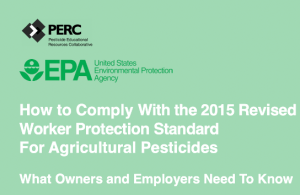Hello Avid Readers! We have new WPS compliance materials available to assist those concerned about staying in compliance with the worker protection standard. If you work on an establishment that produces plants and pesticides are used, this law likely applies to you. Read more to find out if you need to check out these materials!
What is the Worker Protection Standard?
The Worker Protection Standard (WPS) is a law created to reduce the risks of illness and injury to agricultural workers and pesticide handlers resulting from exposure to pesticides during the production of agricultural plants on agricultural establishments. It requires agricultural employers and commercial pesticide handler employers (CPHEs)to provide specific information when WPS-labeled pesticide products are being used. Additionally, it requires owners of agricultural establishments to provide protections for themselves and their immediate families, requires those handling pesticides to wear appropriate personal protective equipment (PPE), and requires protections for persons present during pesticide applications.
Who has WPS Responsibilities?
If you employ persons on an agricultural establishment AND you utilize WPS-labeled pesticides, you have WPS responsibilities. Here are some examples:
- You own or operate an agricultural establishment in plant production.
- You hire or contract for the services of agricultural workers for tasks related to agricultural production.
- You employ researchers who help produce agricultural plants.
- You operate a business in which you or your employees apply pesticides related to the production of agricultural plants.
- You are a pesticide handler who applies WPS-labeled pesticides.
To see if it applies to you check out PERC https://pesticideresources.org/wps/doesitapply.html

What are the Responsible Parties Roles?
There are several roles of responsible parties
- Agricultural employer—owner or manager of an agricultural establishment that employs any worker or handler.
- Commercial Pesticide Handler Employer (CPHE)—owner or manager of a commercial pesticide-handling establishment who employs handlers who perform handler activities on an agricultural establishment.
- Pesticide handler—anyone in direct contact with pesticides such as mixing, loading, or applying. The WPS also covers family-owned agricultural operations.
Who Receives WPS Protections?
There are several groups that require WPS protections from the responsible parties.
Workers are employed in exchange for a salary, and they perform tasks directly related to the production of agricultural plants on an agricultural establishment.

Handlers are employed in exchange for monetary gain by an agricultural establishment or a commercial pesticide-handling establishment that uses pesticides for agricultural plant production.

Crop advisors can be either workers or handlers depending on when they perform their tasks. They are any person who is assessing pest density, damage, pesticide distribution, or status of agricultural plants. Crop advisers are handlers if tasks are performed during pesticide application or the REI. They are considered a worker if tasks are performed after the REI but within 30 days of the REI expiration. All crop advisors must be provided WPS training by their employer.

How do I Comply with the WPS?
Our new WPS compliance materials should help to determine if you have responsibilities, your role, and to whom you are meant to provide WPS protections. We have created an EDIS document, “Worker Protection Standard (WPS) Responsibilities and Compliance”, with quick links to the areas most commonly asked about. In many cases the document will direct you to the PERC How to Comply (HTC) manual. This is the best resource for compliance with the WPS. This new document gives a brief overview and highlights while the HTC has full details of compliance with the law.

We have created a Canvas Course covering WPS compliance. It is essentially an audio-visual version of the new “Worker Protection Standard (WPS) Responsibilities and Compliance”. This will be available in January for CEUs. There will also be a free version for those who need this information, but do not need CEUs.
Summary
In summary, we have two new pieces of material to help those in need to comply with the WPS. The EDIS document, “Worker Protection Standard (WPS) Responsibilities and Compliance” and the Canvas video which will be up in January. These along with the existing HTC manual should be sufficient to answer the majority of questions related to compliance. However, we at the PIO recognize that there are so many unique situations in agriculture that there are bound to be situations that are not clearly defined. Reach out to us when this happens! We are happy to help you figure out how the law applies to your situation.
Additional Materials
PERC has Training Materials for the workers or handlers on your establishment.
References
All photos were taken from the PERC website.
 1
1
